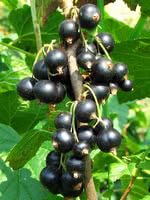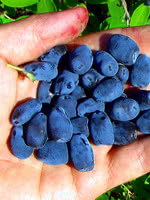Mon-Fri 9am - 5pm Mountain time
Blackcurrant vs Borealis Haskap (Honeyberry)
Ribes nigrum
Lonicera caerulea Borealis
NOT AVAILABLE THIS SEASON - MIGHT RETURN
Blackcurrant is a medium-sized shrub producing delicious, deep purple to black sweet berries suitable for jams, jellies, syrups and cordial.
Our Blackcurrant is grown from seed from the "Ben" series of Blackcurrant cultivars, developed by the Mylnefield Research Station in Scotland with a focus on cold hardiness and heavy commercial fruit production. Our seedlings will be slightly different due to hereditary differences but will be very similar to this series.
Borealis Haskap is a popular variety due to its great-tasting, sweet-tart berries. The flavour of Haskaps is generally described as a cross between a blueberry and a raspberry. Borealis Haskaps are well suited to fresh eating, baking, and preserves.
It has strong fruit holds and is not very firm so it does not do well when handled by equipment. This variety is a favourite for home gardens and U-Picks.
For optimal fruit production, cross-pollination is required. Haskaps need to be planted with a compatible variety. Compatibility is influenced by both bloom time and genetics.
Borealis Haskap is an early-pollinating variety and pairs well with Aurora and Honey Bee.

